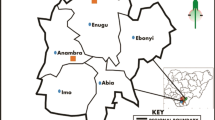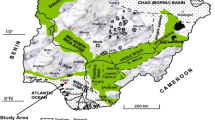Abstract
Gully development and expansion in southeastern Nigeria have threatened humans and the ecosystem, leading to several environmental damages worth millions of dollars. This has drawn the attention of many researchers and environmental stakeholders in recent decades. In this study, an integrated approach involving field survey, geotechnical, and geomorphological assessment was employed to ascertain the erodibility potential of two erosion-prone geologic units in southeastern Nigeria. Based on the field observations, soils from the studied gullies were composed of loose lateritic unconsolidated soils belonging to the Upper Cretaceous (Maastrichtian)—lower Paleocene and middle Eocene. On the basis of the grain size study, it was discovered that the soil components of both geological formations were devoid of finer soil materials. The soil permeability coefficients ranged from 1.13 × 10−5 to 2.45 × 10−4 m/s and 6.18 × 10−5 to 5.25 × 10−4 m/s for the Ajali and Nanka formations, respectively. The maximum dry density (MDD) ranged from 1.69 to 1.90 g/cm3 and 1.72 to 2.10 g/cm3, whereas optimum moisture content (OMC) ranged from 11.0 to 14.30 % and 12.12 to 18.10 % in the compaction test. Indications that the soils are non-plastic to low-plastic were drawn from the natural moisture content (NMC) results and the Atterberg limit. The soil cohesion ranged from 0−6 kPa to 1−7 kPa. The friction angle varied from 23−28o and 32−38o. Results from this study revealed that the soil materials have poor geotechnical properties and are susceptible to erosion due to the prevalence of rainfall in the area. The geomorphological characteristics show that topographically, the region is characterised by undulating and steep gully slope gradients, with the gullies in the Ajali Formation showing higher susceptibility to landslides compared to those of Nanka. Findings from this study have shown that the occurrence of gullies in the area is attributed mainly to poor soil geotechnical properties and geomorphological characteristics.







Similar content being viewed by others
Data availability
There is no external data associated with this manuscript. All the data used have been provided in the submission.
References
Arora KR (2008) Soil mechanics and foundation engineering (geotechnical engineering), 8th edn. Lomus Ofset Press, Delhi, p 953
Bell FG (2007) Engineering Geology, 2nd edn. Butterworth-Heinemann, Elsevier Ltd, Oxford UK, p 593
Brady NC, Weil RR (2008) The soils around us. The nature and properties of soils, 14th ed Pearson Prentice Hall, New Jersey and Ohio, pp 1–31
Casagrande A, Fadum RE (1940) Notes on soil testing for engineering purposes. Harvard Univ. Graduate School of Engg, Publication No.8
Chaulya SK (1993) Estimation of dump stability of an opencast mine dump M. Tech thesis. Department of Mining Engineering, Institute Technology, Banaras Hindu University, Varanasi, India
Chow VT (1969) Spatially varied flow equations. Water Resour Res 5(5):1124–1128
Crozier MJ (1984) Field assessment of slope instability. In: Brunsden D, Prior D (eds) Slope instability. Wiley, New York, p 620
Egboka BCE, Nwankwor GI (1985) The hydrogeological and geotechnical parameters as agent for gully-type erosion in the rainforest Belt of Nigeria. J Afr Earth Sci 3(4):417–425
Egboka, B.C.E and Okpoko, E.I. (1984) Gully erosion in the Agulu-Nanka region of Anambra State, Nigeria. Challenges in African Hydrology and Water Resources: Proceedings of the Harare Symposium, IAHS Publ., v .144, pp.335–347
Egboka BCE, Orji AE, Nwankwoala HO (2019) Gully erosion and landslides in southeastern Nigeria: causes, consequences and control measures. Glob J Eng Sci. https://doi.org/10.33552/GJES.2019.02.000541
Egbueri JC, Igwe O (2020) The impact of hydrogeomorphological characteristics on gullying processes in erosion-prone geological units in parts of Southeast Nigeria. Geol Ecol Landsc. https://doi.org/10.1080/24749.508.2020.17116.37
Egbueri JC, Unigwe CO (2020) Understanding the extent of heavy metal pollution in drinking water supplies from Umunya, Nigeria: an indexical and statistical assessment. Anal Lett. https://doi.org/10.1080/00032719.2020.1731521
Egbueri JC, Igwe O, Nnamani CH (2017) Assessment of the engineering properties and suitability of some tropical soils as back-fill materials. International Journal of Trend in Science Resource and Development. https://doi.org/10.31142/ijtsrd7041
Egbueri JC, Mgbenu CN, Chukwu CN (2019) Investigating the hydrogeochemical processes and quality of water resources in Ojoto and environs using integrated classical methods. Model Earth Syst Environ. https://doi.org/10.1007/s40808-019-00613-y
Egbueri JC, Igwe O, Unigwe CO (2021) Gully slope distribution characteristics and stability analysis for soil erosion risk ranking in parts of southeastern Nigeria: a case study. Environ Earth Sci. https://doi.org/10.1007/s12665-021-09605-7
Ekwenye OC, Nichols GJ, Collinson M, Nwajide CS, Obi GC (2014) A paleogeographic model for the sandstone members of the Imo Shale, South Eastern Nigeria. J Afr Earth Sci 96:190–211
Emeh C, Igwe O (2017) Variations in soils derived from an erodible sandstone formation and factors controlling their susceptibility to erosion and landslide. J Geol Soc India 90(3):259–384
Highland LM, Bobrowsky P (2008) The landslide handbook: a guide to understanding landslides.US Geological Survey, Circular 1325. U.S. Geological Survey, Reston, p 129
Horton RE (1945) Erosional development of streams and their drain-age basins; hydrophysical approach to quantitative morphology. Geol Soc Am Bull 56(3):275–370
Hudec PP, Simpson F, Akpokodje EG, Umenweke MO (2006) Termination of gully processes, Southeastern Nigeria. Proceedings of the Eighth Federal Interagency Sedimentation Conference (8th FISC), April 2-6, 2006, Reno, NV, USA, pp.671-679
Igbokwe JI, Akinyede JOB, Dang BT, Alaga TMN, Ono MN, Nnodu VC, Anike LO (2008) Map** and monitoring of the impact of gully erosion in southeastern Nigeria with satellite remote sensing and geo-graphic information system. Int Arch Photogramm Remote Sens Spat Inf Sci 37:865–871
Igwe CA (2012) Gully erosion in southeastern Nigeria: role of soil properties and environmental factors. In: Danilo G (ed) Research on Soil Erosion. In Tech. https://doi.org/10.5772/51020
Igwe O (2015) Predisposing factors and themechanisms of rainfall-induced slope movements in Ugwueme, South-East Nigeria. Bull Eng Geol Environ. https://doi.org/10.1007/s10064-015-0767-0
Igwe O (2017) The hydrogeological attributes and mechanisms of a receding sedimentary terrain in the Anambra Basin Southern Nigeria. Environ Earth Sci 76(1):1–22
Igwe O, Egbueri JC (2018) The characteristics and the erodibility potentials of soils from different geologic formations in Anambra State Southeastern Nigeria. J Geol Soc India 92:471–478. https://doi.org/10.1007/s12594-018-1044-1
Igwe O, Fukuoka H (2010) Environmental and socio-economic impact of erosion in Nigeria, West Africa. Int J Erosion Control Eng 3(1):102–109
Igwe O, Una CO (2019) Landslide impacts and management in Nanka area Southeast Nigeria. Geoenviron Dis 6:5. https://doi.org/10.1186/s40677-019-0122-z
Igwe O, Mode W, Nnebedum O, Okonkwo I, Oha I (2013) The analysis of rainfall-induced slope failures at Iva Valley area of Enugu State. Nigeria, Environ. Earth Sci. https://doi.org/10.1007/s12665-013-2647-x
Inyang PEB (1978) The climate of Nsukka and environs. The Nsukka Environment. Fourth Dimension Publishers, Enugu Nigeria
Isikwue MO, Abutu C, Onoja SB (2012) Erodibility of soils of the South West Benue State Nigeria. Pacific J Sci Technol 3(2):437–447
Kahlon MS, Khera KL (2000) Evaluation of soil erodibility in relation to soil physical properties. J Indian Soc Soil Sci 48:205–206
Kalinski ME (2011) Soil Mechanics Lab Manual, 2nd edn. John Wiley & Sons, Inc, United States of America, p 193
Khamkar DJ, Mhaske SY (2018) Identification of landslide susceptible settlements using geographical information system of Yelwandi river basin Maharashtra (India). Nat Hazards. https://doi.org/10.1007/s11069-019-03609-0
Manyatsi AM (1998) Soil erosion and control training Mmanual. Environmental Consulting Services, Mbabane, Swaziland, pp 1–13
Murat RG (1972) Stratigraphy and paleogeography of the Cretaceous and Lower Tertiary in Southern Nigeria. In: Dessauvagie TFJ, Whiteman AJ (eds) African Geology. University of Ibadan Press, pp 251–266
Nazari Samani A, Ahmadi H, Jafari M, Boggs G, Ghoddousi J, Malekian A (2009) Geomorphic threshold for gully erosion in southwestern Iran (Boushehr-Samal watershed). J Asian Earth Sci 35:180–189
Nebeokike UC, Igwe O, Egbueri JC, Ifediegwu SI (2020) Erodibility characteristics and slope stability analysis of geological units prone to erosion in Udi area Southeast Nigeria. Model Earth Syst Environ 6:1061–1074. https://doi.org/10.1007/s40808-020-00741-w
Nwajide CS (1992) Gullying in the Idemilli river catchment, Anambra site. Nigeria. Theory and cure. In: S.J. Freeth, C.O
Nwajide CS (2013) Geology of Nigeria’s Sedimentary Basins. CSS Bookshops Limited, Nigeria, p 565
Nwajide CS, Hoque H (1979) Gullying processes in south eastern Nigeria. The Nigerian Fields, pp 64–74
Obaje NG (2009) Geology and mineral resources of Nigeria. Springer-Verlag Berlin Heidelberg, New York, p 219
Obi GC (2000) Depositional model for the Campanian-Maastrichtian Anambra Basin, Southeastern Nigeria. Ph.D. Thesis. Department of Geology, University of Nigeria, Nsukka, p 286
Obiadi II, Nwosu CM, Ajaegwu NE, Anakwuba EK, Onuigbo NE, Akpunonu EO, Ezim OE (2011) Gully erosion in Anambra State, South East Nigeria: issues and solution. Int J Environ Sci 2(2)
Odunze OS, Obi GC (2013) Sedimentology and sequence stratigraphy of the Nkporo group (Campanian–Maastrichtian), Anambra Basin Nigeria. J Paleogeogr 2(2):192–208
Okagbue CO (1988) A landslide in a quasi-stable slope. Eng Geol 25:69–82
Okagbue CO, Ezechi JC (1988) Geotechnical characteristics of soils susceptible to severe gullying in eastern Nigeria. Bull Int Assoc Eng Geol 38:111–119
Omeka ME, Igwe O, Unigwe CO (2022) An integrated approach to the bioavailability, ecological, and health risk assessment of potentially toxic elements in soils within a barite mining area SE Nigeria. Environ Mont Assess 194(3):212. https://doi.org/10.1007/s10661-022-09856-2
Poesen J (2011) Challenges in gully erosion research. Landform Analysis 17:5–9
Reyment RA (1965) Aspects of geology of Nigeria: the stratigraphy of Cretaceous and Cenozoic deposits. Ibadan University Press, Ibadan, p 145
Unigwe CO, Egbueri JC (2021) Drinking water quality assessment based on statistical analysis and three water quality indices (MWQI, IWQI and EWQI): a case study. Environ Dev Sustain. https://doi.org/10.1007/s10668-021-02076-7
Unigwe CO, Egbueri JC, Omeka EM (2022b) Geospatial and statistical approaches to nitrate health risk and groundwater quality assess-ment of an alluvial aquifer in SE Nigeria for drinking and irriga-tion purposes. J Indian Chem Soc 99:100479. https://doi.org/10.1016/j.jics.2022.100479
Unigwe CO, Igwe O, Onwuka OS, Omeka EM, Egbueri JC (2022a) Roles of hydro-geotechnical and slope stability characteristics in the erosion of Ajali and Nanka geologic formations in southeastern Nigeria. Arab J Geosci. https://doi.org/10.1007/s12517-022-10771-6
Author information
Authors and Affiliations
Corresponding author
Ethics declarations
Compliance with ethical standard
The authors certify that this paper is written in line with the journal's ethical guidelines.
Informed consent
Not applicable.
Conflict of interest
The author(s) declare that they have no competing interests.
Additional information
Responsible Editor: Zeynal Abiddin Erguler
Rights and permissions
About this article
Cite this article
Unigwe, C.O., Igwe, O., Onwuka, O.S. et al. Understanding the influence of geotechnical and geomorphological characteristics on the erosional processes of two geologic units in Udi and Aguata, SE Nigeria. Arab J Geosci 16, 231 (2023). https://doi.org/10.1007/s12517-023-11311-6
Received:
Accepted:
Published:
DOI: https://doi.org/10.1007/s12517-023-11311-6




